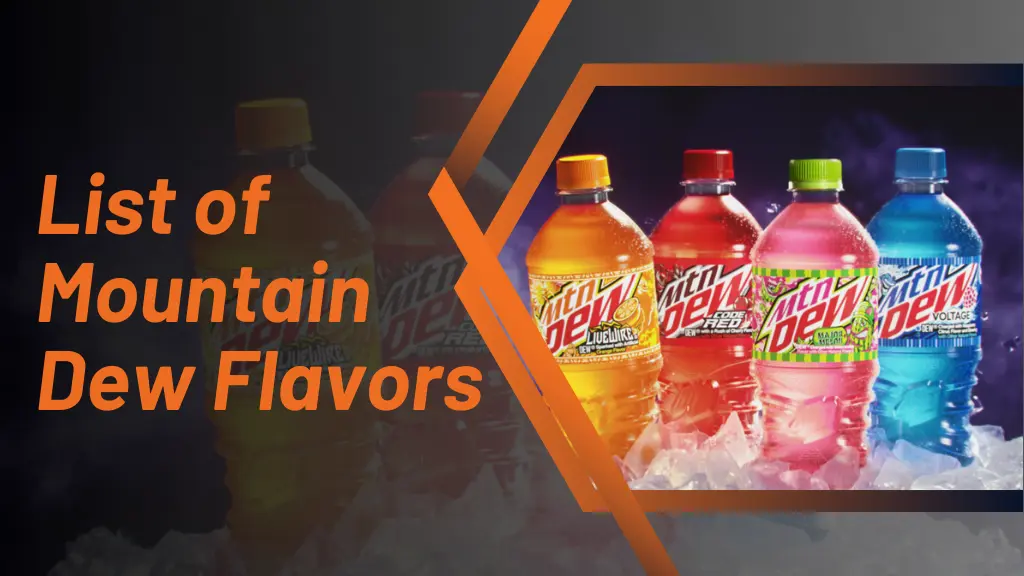The list of Mountain Dew flavors is one of the most fascinating examples of how a soft drink brand can expand beyond its original formula to become a cultural phenomenon. What started as a regional citrus soda in the 1940s has transformed into an international sensation with dozens of permanent, seasonal, and limited-edition varieties. Each new flavor represents more than just a drink; it reflects Mountain Dew’s ability to innovate, connect with fans, and stay ahead of changing trends in the beverage industry. Today, Mountain Dew is not just a soda it is a symbol of boldness, energy, and creativity.
The Rise of Mountain Dew’s Flavor Experiments
The success of Mountain Dew’s original citrus formula created the foundation for experimentation. As consumer demands evolved, PepsiCo saw an opportunity to create a brand that wasn’t afraid to take risks. In the late 20th century, new flavors were introduced to attract younger audiences, particularly gamers, sports enthusiasts, and fans of unique taste experiences. By stepping beyond the boundaries of traditional sodas, Mountain Dew built a reputation as the brand that dared to try what others wouldn’t.
The Core Flavors That Defined the Brand
Mountain Dew’s foundation is built on a few core flavors that became instant hits. The original flavor, with its sharp citrus profile, remains a favorite for those who want a classic refreshing taste. Code Red, released in 2001, introduced cherry flavoring and became an immediate success. Voltage added raspberry and ginseng for a more energizing profile, appealing to fans of stronger blends. Baja Blast, originally exclusive to Taco Bell, introduced tropical lime flavors that developed a cult following so strong that fans demanded retail versions. Each of these flavors has become more than just a drink; they represent milestones in the brand’s history.
Seasonal and Limited-Time Releases
Part of the excitement surrounding Mountain Dew is its limited-time and seasonal varieties. Flavors such as LiveWire, a bold orange version available primarily in the summer, became seasonal favorites. Game Fuel, first tied to video game promotions, was another example of how Mountain Dew positioned itself as the drink of choice for gamers. These limited editions often spark conversations online, as fans race to try them before they disappear. The thrill of exclusivity keeps Mountain Dew in the spotlight and ensures customers remain engaged year-round.
Innovation Through Collaboration
Mountain Dew is not just about the drink, it’s about experiences. Collaborations have played a major role in expanding its list of flavors. Baja Blast’s Taco Bell partnership is one of the most famous examples of cross-branding success. Other collaborations include flavors tied to movie releases, sports events, and gaming competitions. These partnerships not only introduce new flavors but also align Mountain Dew with cultural moments that resonate with its audience.
International Variants of Mountain Dew
Globally, Mountain Dew’s flavor experimentation is even more diverse. In Japan, the company has released flavors inspired by grape sodas and melon-based drinks. In the Middle East and South Asia, tropical and spicy variations appeal to local palates. Some countries enjoy unique flavors that never reach U.S. shelves, making them highly collectible for dedicated fans. The international expansion of flavors shows Mountain Dew’s versatility and its ability to adapt to cultural preferences around the world.
Sugar-Free and Health-Conscious Options
As consumers grow more health-conscious, Mountain Dew has adjusted its offerings. Diet Mountain Dew and Mountain Dew Zero Sugar replicate the iconic taste without the calories. Fans of Code Red, Baja Blast, and even seasonal varieties can often find zero-sugar alternatives. This expansion into healthier options ensures Mountain Dew remains relevant in a market where many are reducing sugar consumption but still craving bold flavor.
Marketing, Branding, and Flavor Identity
Mountain Dew’s flavors are not just products; they are part of a larger branding strategy. Each new release comes with creative packaging, bold colors, and campaigns that align with Mountain Dew’s adventurous image. Flavors often launch with edgy commercials, partnerships with athletes or gamers, and limited-edition artwork on bottles and cans. This marketing approach turns flavors into cultural moments rather than simple product launches.
The brand also understands the importance of storytelling. Each flavor has a backstory, whether tied to a season, a cultural event, or a collaboration. This narrative-driven marketing creates emotional connections with consumers, making each flavor more memorable.
The Fan Culture Around Mountain Dew Flavors
Mountain Dew’s popularity goes beyond drinking the soda; it’s about being part of a community. Fans eagerly await announcements of new flavors, often speculating on social media and sharing reviews once they launch. Limited-time packaging and promotional tie-ins add to the excitement, encouraging fans to collect bottles and cans. Online groups and forums rank flavors, debate the best limited releases, and even petition PepsiCo to bring back discontinued options. This passionate fan culture has helped Mountain Dew remain at the center of pop culture conversations.
Collectibility and Nostalgia
The collectible aspect of Mountain Dew cannot be overlooked. Rare cans, international editions, and discontinued flavors often become valuable to enthusiasts. Nostalgia also plays a role. Fans who grew up with LiveWire or Game Fuel often reminisce about those experiences and hope to see their return. The constant cycle of new releases, retirements, and fan requests has created a living history of flavors that continues to grow.
Cultural Impact of Mountain Dew Flavors
Another reason Mountain Dew stands out is its cultural influence. The brand has consistently marketed itself as more than a beverage closely tied to gaming, extreme sports, and youth culture. Its association with high-energy lifestyles has made it a staple at sporting events, music festivals, and eSports tournaments. By linking different flavors with cultural movements, Mountain Dew has ensured that its brand remains fresh and exciting, even decades after its first launch.
Beyond sports and gaming, Mountain Dew has also become a pop culture symbol. References in music, movies, and even memes demonstrate its lasting relevance. When fans share photos of new flavors online or create ranking videos, they contribute to Mountain Dew’s ongoing presence in digital culture.
Why the List of Mountain Dew Flavors Keeps Expanding
PepsiCo understands its audience better than most beverage companies. Unlike traditional sodas that stick to one or two variations, Mountain Dew thrives on novelty and experimentation. Each new flavor is a chance to test consumer reactions, explore bold ideas, and strengthen the brand’s adventurous identity. Whether it’s creating tropical blends, berry-based infusions, or limited-time exclusives tied to entertainment events, Mountain Dew thrives by being unpredictable.
Conclusion
The list of Mountain Dew flavors is far more than a catalog of sodas; it is a reflection of how a brand can evolve and remain relevant through constant innovation. From the original citrus soda to cult classics like Baja Blast and experimental Game Fuel editions, Mountain Dew’s journey has been one of creativity and boldness. Fans can expect the legacy to continue with new releases, international variants, and healthier options. Mountain Dew has proven that its future will be as adventurous as its past, ensuring that it remains a favorite for generations to come.
FAQs
What is the most popular Mountain Dew flavor?
The original Mountain Dew remains the most widely consumed, but Baja Blast and Code Red are often ranked as fan favorites thanks to their unique taste and cult followings.
How many Mountain Dew flavors exist?
There have been dozens of official Mountain Dew flavors released over the years, including permanent, seasonal, and international editions. The exact number changes as new ones are added and old ones are discontinued.
Which Mountain Dew flavors are sugar-free?
Diet Mountain Dew and Mountain Dew Zero Sugar are the most common sugar-free options. In recent years, other popular varieties such as Baja Blast and Code Red have also received zero-sugar versions.
Are there Mountain Dew flavors only available internationally?
Yes, certain flavors are exclusive to specific countries. For example, Japan has released melon and grape-inspired versions, while other regions enjoy tropical or spiced variations not sold in the U.S.
Why does Mountain Dew release limited-time flavors?
Limited-time flavors create excitement and urgency among fans. They also allow Mountain Dew to experiment with new taste profiles while building hype around seasonal events, gaming launches, or brand collaborations.





